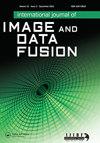A context-driven pansharpening method using superpixel based texture analysis
IF 1.8
Q3 REMOTE SENSING
International Journal of Image and Data Fusion
Pub Date : 2020-11-11
DOI:10.1080/19479832.2020.1845244
引用次数: 3
Abstract
ABSTRACT In this paper, we propose a context-driven injection scheme for pansharpening, in which the injection coefficients are computed over superpixel segments obtained by means of a modified Simple Linear Iterative Clustering (t-SLIC) technique applied on the texture descriptors of the PAN image. By using the t-SLIC algorithm, various homogeneous-connected components can be generated according to their spectral properties. The proposed pansharpening method relies on a multiresolution framework by employing the Generalized Laplacian Pyramid (GLP) tailored to the Modulation Transfer Function (MTF) of the MS sensors for extracting the high frequency details. First, the injection gains are locally computed as regression coefficients between the upsampled MS and low-resolution PAN regions at a reduced scale. Then, they are multiplied by a global weighting factor computed per spectral band and defined as the ratio of variance between expanded MS bands and PAN image. Finally, the spatial details are modulated by means of the estimated global-local injection coefficients at superpixel level to produce the high-resolution MS image. The validation is assessed with two datasets acquired by IKONOS and WorldView-3 satellites. The experimental results show that the proposed method achieves a favourable performance both visually and quantitatively compared to the state of-the-art pansharpening algorithms.基于超像素纹理分析的上下文驱动泛锐化方法
本文提出了一种上下文驱动的泛锐化注入方案,该方案利用改进的简单线性迭代聚类(t-SLIC)技术对PAN图像的纹理描述符获得的超像素片段计算注入系数。利用t-SLIC算法,可以根据谱性质生成各种齐次连通分量。提出的泛锐化方法基于多分辨率框架,采用针对质谱传感器调制传递函数(MTF)定制的广义拉普拉斯金字塔(GLP)提取高频细节。首先,注入增益局部计算为上采样MS和低分辨率PAN区域之间的回归系数。然后,将它们乘以每个光谱波段计算的全局加权因子,并将其定义为扩展MS波段与PAN图像之间的方差之比。最后,利用估计的全局局部注入系数在超像素级对空间细节进行调制,得到高分辨率的质谱图像。利用IKONOS和WorldView-3卫星获得的两个数据集对验证进行了评估。实验结果表明,与现有的泛锐化算法相比,该方法在视觉上和定量上都取得了较好的效果。
本文章由计算机程序翻译,如有差异,请以英文原文为准。
求助全文
约1分钟内获得全文
求助全文
来源期刊

International Journal of Image and Data Fusion
REMOTE SENSING-
CiteScore
5.00
自引率
0.00%
发文量
10
期刊介绍:
International Journal of Image and Data Fusion provides a single source of information for all aspects of image and data fusion methodologies, developments, techniques and applications. Image and data fusion techniques are important for combining the many sources of satellite, airborne and ground based imaging systems, and integrating these with other related data sets for enhanced information extraction and decision making. Image and data fusion aims at the integration of multi-sensor, multi-temporal, multi-resolution and multi-platform image data, together with geospatial data, GIS, in-situ, and other statistical data sets for improved information extraction, as well as to increase the reliability of the information. This leads to more accurate information that provides for robust operational performance, i.e. increased confidence, reduced ambiguity and improved classification enabling evidence based management. The journal welcomes original research papers, review papers, shorter letters, technical articles, book reviews and conference reports in all areas of image and data fusion including, but not limited to, the following aspects and topics: • Automatic registration/geometric aspects of fusing images with different spatial, spectral, temporal resolutions; phase information; or acquired in different modes • Pixel, feature and decision level fusion algorithms and methodologies • Data Assimilation: fusing data with models • Multi-source classification and information extraction • Integration of satellite, airborne and terrestrial sensor systems • Fusing temporal data sets for change detection studies (e.g. for Land Cover/Land Use Change studies) • Image and data mining from multi-platform, multi-source, multi-scale, multi-temporal data sets (e.g. geometric information, topological information, statistical information, etc.).
 求助内容:
求助内容: 应助结果提醒方式:
应助结果提醒方式:


